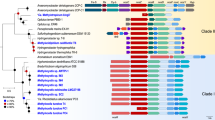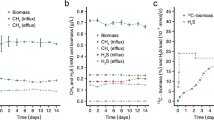Abstract
H2 thresholds, concentrations below which H2 consumption by a microbial group stops, have been associated with microbial respiratory processes such as dechlorination, denitrification, sulfate reduction, and methanogenesis. Researchers have proposed that observed H2 thresholds occur when the available Gibbs free energy is minimal (ΔG ≈ 0) for a specific respiratory reaction. Others suggest that microbial kinetics also may play a role in controlling the thresholds. Here, we comprehensively evaluate H2 thresholds in light of microbial thermodynamic and kinetic principles. We show that a thermodynamic H2 threshold for Methanobacterium bryantii M.o.H. is not controlled by ΔG for methane production from H2 + HCO −3 . We repeatedly attain a H2 threshold near 0.4 nM, with a range of 0.2–1 nM, and ΔG for methanogenesis from H2 + HCO −3 is positive, +5 to +7 kJ/mol-H2, at the threshold in most cases. We postulate that the H2 threshold is controlled by a separate reaction other than methane production. The electrons from H2 oxidation are transferred to an electron sink that is a solid-phase component of the cells. We also show that a kinetic threshold (S min) occurs at a theoretically computed H2 concentration of about 2400 nM at which biomass growth shifts from positive to negative.







Similar content being viewed by others
References
Benstead J, Archer DB, Lloyd D (1991) Formate utilization by members of the genus Methanobacterium. Arch Microbiol 156:34–37
Blaut M, Muller V, Gottschalk G (1992) Energetics of methanogenesis studied in vesicular systems. J Bioenerg Biomembr 24:529–546
Boone DR (1987) Replacement of the type strain of Methanobacterium formicicum and reinstatement of Methanobacterium bryantii sp. nov. nom. Rev. (ex Balch and Wolfe, 1981) with M.o.H. (DSM 863) as the type strain. Int J Syst Bacteriol 37:172–173
Boone DR, Mah R (1989) Methanogenic archeobacteria. In: Murray RGE, Holt JG, Staley JT, Pfenning N (Eds) Bergey’s manual of systematic bacteriology. Williams & Wilkins, Baltimore, pp 2175–2177
Brown DG, Komlos J, Jaffé P (2005) Simultaneous utilization of acetate and hydrogen by Geobacter sulfurreducen and implications for use of hydrogen as an indicator of redox conditions. Environ Sci Technol 39:3069–3076
Chapelle FH, Haack SK, Adriaens P, Henry MA, Bradley PM (1996) Comparison of Eh and H2 measurements for delineating redox processes in a contaminated aquifer. Environ Sci Technol 30:3565–3569
Conrad R, Aragno M, Seiler W (1983) The inability of hydrogen bacteria to utilize atmospheric H2 is due to threshold and affinity for hydrogen. FEMS Microbiol Lett 18:207–210
Conrad R, Wetter B (1990) Influence of temperature on energetics of hydrogen metabolism in homoacetogenic, methanogenic, and other anaerobic bacteria. Arch Microbiol 155:94–98
Conrad R (1996) Soil microorganisms as controllers of atmospheric trace gases (H2, CO2, CH4, OCS, N2O, and NO). Microbiol Rev 60:609–640
Cord-Ruwisch R, Seitz H-J, Conrad R (1988) The capacity of hydrogenotrophic anaerobic bacteria to compete for traces of hydrogen depends on the redox potential of the terminal electron acceptor. Arch Microbiol 149:350–357
Deppenmeier U (2002) The unique biochemistry of methanogenesis. Prog Nucleic Acid Res Mol Biol 71:223–283
Deutsche Sammlung von Mikroorganismen und ZellKulturen GmbH. http://www.dsmz.de or http://www2.dsmz.de
Dolfing J, Janssen DB (1994) Estimates of Gibbs free energies of formation of chlorinated aliphatic compounds. Biodegredation 5:21–28
Häring V, Conrad R (1991) Kinetics of H2 oxidation in respiring and denitrifying Paracoccus denitrificans. FEMS Microbiol Lett 78:259–264
Hoehler TM, Alperin MJ, Albert DB, Martens CS (1998) Thermodynamic control on hydrogen concentrations in anoxic sediments. Geochim Cosmochim Acta 62:1745–1756
Jackson BE, McInerney MJ (2001) Anaerobic microbial metabolism can proceed close to thermodynamic limits. Nature 415:454–456
Karadagli F, Rittmann BE (2005) Kinetic characterization of Methanobacterium bryantii M.o.H. Environ Sci Technol 39:4900–4905
Kassenga G, Pardue JH, Moe WM et al (2004) Hydrogen thresholds as indicators of dehalorespiration in constructed treatment wetlands. Environ Sci and Technol 38:1024–1030
Klüber HD, Conrad R (1993) Ferric iron-reducing Shewanella putrifaciens and N2-fixing Bradyrhizobium japonicum with uptake hydrogenase are unable to oxidize atmospheric H2. FEMS Microbiol Lett 111:337–342
Kotsyurbenko OR, Glagolev MV, Nozhevnikova AN, Conrad R (2001) Competition between homoacetogenic bacteria and methanogenic archea for hydrogen at low temperature. FEMS Microbiol Ecol 38:153–159
Krumholz LR, Harris SH, Tay ST, Suflita JM (1999) Characterization of two subsurface H2-utilizing bacteria, Desulfomicrobium hypogenium sp. nov. and Acetobacterium psammolithicum sp. nov., and their ecological roles. Appl Environ Microbiol 65: 2300–2306
Krüger M, Meyerdierks A, Gröckner FO, Amann R, Widdel F et al (2003) A conspicous nickel protein in microbial mats that oxidize methane anaerobically. Nature 426:878–881
Lee MJ, Zinder SH (1988) Hydrogen partial pressures in a thermophilic acetate-oxidizing methanogenic coculture. Appl Environ Microbiol 54:1457–1461
Ljungdahl LG, Wiegel J (1986) Working with anaerobic bacteria. In: Demain AL, Solomon NA (Eds) Manual of industrial microbiology and biotechnology. Amer. Soc. Microbiol., Washington, D.C., pp 84–96
Lovley DR, Dwyer DF, Klug MJ (1982) Sulfate reducers can outcompete methanogens at freshwater sulfate concentrations. Appl Environ Microbiol 43:1373–1379
Lovley DR, Klug MJ (1983) Kinetic analysis of competition between sulfate reducers and methanogens for hydrogen in sediments. Appl Environ Microbiol 43:187–192
Lovley DR (1985) Minimum threshold for hydrogen metabolism in Methanogenic Bacteria. Appl Environ Microbiol 49:1530–1531
Lovley DR, Goodwin ST (1988) Hydrogen concentrations as an indicator of the predominant terminal electron-accepting reactions in aquatic sediments. Geochim Cosmochim Acta 52:2993–3003
Lovley DR, Chapelle FH, Woodward JC (1994) Use of dissolved H2 concentrations to determine distribution of microbially catalyzed redox reactions in anoxic groundwater. Environ Sci Technol 28:1205–1210
Löffler FE, Champine JM, Ritalahti KM, Sprague SJ, Tiedje JM (1997) Complete reductive dechlorination of 1,2-Dichlorpropane by anaerobic bacteria. Appl Environ Microbiol 63:2870–2875
Löffler FE, Tiedje JM, Sanford RA (1999) Fraction of electrons consumed in electron acceptor reduction and hydrogen threshold as indicators of halorespiratory physiology. Appl Environ Microbiol 65:1373–1379
Lu XX, Tao S, Bosma T, Gerritse J (2004) Characteristic hydrogen concentrations for various redox processes in batch study. J Environ Sci Health Part A 36:1725–1734
Luijten MLGC, Roelofsen W, Langenhoff AAM, Schraa G, Stams AJM (2004) Hydrogen threshold concentrations in pure cultures of halorespiring bacteria and at site polluted with chlorinated ethenes. Environ Microbiol 6:646–650
Mägli A, Martingo FA, Leisinger T (1995) Acetogenesis from dichloromethane by a two-component mixed culture comprising a novel bacterium. Appl Environ Microbiol 61:2943–2949
Manahan SE (1994) Environmental chemistry, 6th edn. Lewis Publishers, Boca Raton, Florida
Mazur CS, Jones WJ (2001) Hydrogen concentrations in sulfate-reducing estuarine sediments during PCE dehalogenation. Environ Sci Technol 35:4783–4788
Monod J (1949) The growth of bacterial cultures. Annu Rev Microbiol 3:371–394
Namkung E, Rittmann BE (1987) Evaluation of bisubstrate secondary utilization kinetics by biofilms. Biotechnol and Bioengin 29:335–342
Nicholls DG, Ferguson SJ (2002) Bioenergetics 3. Academic Press, London
Peinemann S, Hedderich R, Blaut M, Thauer R, Gottschalk G (1990) ATP synthesis coupled to electron transfer from H2 to the heterodisulfide of 2-mercaptoethanosulfonate and 7-mercaptoheptanoylthreonine phosphate in vesicle preparations of the methanogenic bacterium strain Gö1. FEBS Lett 263:57–60
Rittmann BE, McCarty PL (1980a) Model of steady-state-biofilm kinetics. Biotech Bioeng 22:2343–2357
Rittmann BE, McCarty PL (1980b) Model of steady-state-biofilm kinetics. Biotech Bioeng 22:2359–2373
Rittmann BE, McCarty PL (2001) Environmental biotechnology: Principles and applications. McGraw-Hill, New York
Robinson JA, Tiedje JM (1984) Competition between sulfate-reducing and methanogenic bacteria for H2 under resting and growing conditions. Arch Microbiol 137:26–32
Schink B (1997) Energetics of syntrophic cooperation in methanogenic degradation. Microbiol Mol Biol Rev 61:262–280
Seitz H-J, Schink B, Conrad R (1988) Thermodynamics of hydrogen metabolism in methanogenic cocultures degrading ethanol and lactate. FEMS Microbiol Lett 55:119–124
Shrout JD, Scheetz TE, Casavant TL et al (2005) Isolation and characterization of autotrophic, hydrogen-utilizing, perchlorate-reducing bacteria. App Microbiol Biotech 67:261–268
Straub KL, Benz M, Schink B (2001) Iron metabolism in anoxic environments at near neutral pH. FEMS Microbiol Ecol 34:181–186
Stumm W, Morgan JJ (1996) Aquatic chemistry: Chemical equilibria and rates in natural waters, 3rd edn. John-Wiley and Sons, Inc., New York
Thauer RK (1998) Biochemistry of methanogenesis: a tribute to Marjory Stephenson. Microbiology 144:2377–2406
Tiedje JM (1988) Ecology of denitirification and dissimilatory nitrate reduction to ammonium. In: Zehnder AJB (Eds) Biology of anaerobic organisms. John-Wiley and Sons, Inc., New York, pp 179–244
Valentine DL, Blanton DC, Reeburgh WS (2000) Hydrogen production by methanogens under low-hydrogen conditions. Arch Microbiol 174:415–421
Widdel F (1988) Microbiology and ecology of sulfate- and sulfur-reducing bacteria. In: Zehnder AJB (Eds) Biology of anaerobic organisms. John-Wiley and Sons, Inc., New York, pp 469–585
Yang Y, McCarty PL (1998) Competition for hydrogen within a chlorinated solvent dehalogenating anaerobic mixed culture. Environ Sci Technol 32:3591–3597
Ye RW, Averill BA, Tiedje JM (1994) Denitrification: production and consumption of nitric oxide. Appl Environ Microbiol 60:1053–1058
Zinder SH (1993) Physiological ecology of methanogens. In: Ferry JG (Eds) Methanogenesis: Ecology, pysiology, biochemistry, and genetics. Chapman and Hall, Inc., New York, pp 128–206
Zehnder AJB (ed) (1988) Biology of anaerobic microorganisms. John Wiley & Sons, New York
Acknowledgments
The authors thank Prof. David A. Stahl and Dr. Bradley E. Jackson for their invaluable comments and contributions at different stages of this research.
Author information
Authors and Affiliations
Corresponding author
Rights and permissions
About this article
Cite this article
Karadagli, F., Rittmann, B.E. Thermodynamic and kinetic analysis of the H2 threshold for Methanobacterium bryantii M.o.H. Biodegradation 18, 439–452 (2007). https://doi.org/10.1007/s10532-006-9073-7
Received:
Accepted:
Published:
Issue Date:
DOI: https://doi.org/10.1007/s10532-006-9073-7




